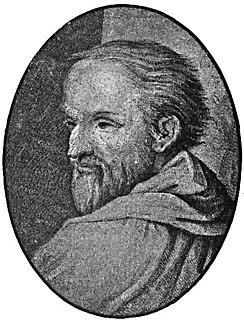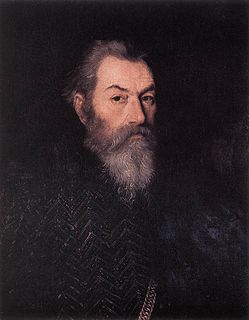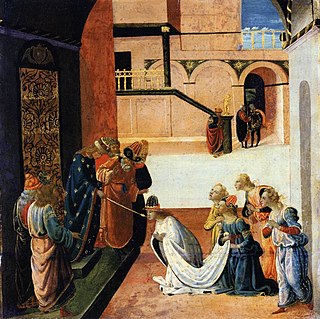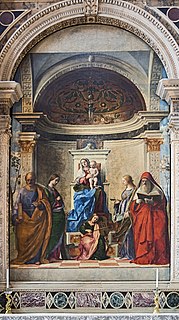
Antonio Allegri da Correggio, usually known as just Correggio, was the foremost painter of the Parma school of the High Italian Renaissance, who was responsible for some of the most vigorous and sensuous works of the sixteenth century. In his use of dynamic composition, illusionistic perspective and dramatic foreshortening, Correggio prefigured the Baroque art of the seventeenth century and the Rococo art of the eighteenth century. He is considered a master of chiaroscuro.

Paolo Caliari, known as Paolo Veronese, was an Italian Renaissance painter based in Venice, known for extremely large history paintings of religion and mythology, such as The Wedding at Cana (1563) and The Feast in the House of Levi (1573). Included with Titian, a generation older, and Tintoretto, a decade senior, Veronese is one of the "great trio that dominated Venetian painting of the cinquecento" and the Late Renaissance in the 16th century. Known as a supreme colorist, and after an early period with Mannerism, Paolo Veronese developed a naturalist style of painting, influenced by Titian.

Simon Vouet was a French painter who studied and rose to prominence in Italy before being summoned by Louis XIII to serve as Premier peintre du Roi in France. He and his studio of artists created religious and mythological paintings, portraits, frescoes, tapestries, and massive decorative schemes for the king and for wealthy patrons, including Richelieu. During this time, "Vouet was indisputably the leading artist in Paris," and was immensely influential in introducing the Italian Baroque style of painting to France. He was also "without doubt one of the outstanding seventeenth-century draughtsmen, equal to Annibale Carracci and Lanfranco."

The Gallerie dell'Accademia is a museum gallery of pre-19th-century art in Venice, northern Italy. It is housed in the Scuola della Carità on the south bank of the Grand Canal, within the sestiere of Dorsoduro. It was originally the gallery of the Accademia di Belle Arti di Venezia, the art academy of Venice, from which it became independent in 1879, and for which the Ponte dell'Accademia and the Accademia boat landing station for the vaporetto water bus are named. The two institutions remained in the same building until 2004, when the art school moved to the Ospedale degli Incurabili.

Paolo Farinati was an Italian painter of the Mannerist style, active in mainly in his native Verona, but also in Mantua and Venice.

Giovanni di Paolo di Grazia was an Italian painter, working primarily in Siena, becoming a prolific painter and illustrator of manuscripts, including Dante's texts. He was one of the most important painters of the 15th century Sienese School. His early works show the influence of earlier Sienese masters, but his later style was more individual, characterized by cold, harsh colours and elongated forms. His style also took on the influence of International Gothic artists such as Gentile da Fabriano. Many of his works have an unusual dreamlike atmosphere, such as the surrealistic Miracle of St. Nicholas of Tolentino painted about 1455 and now housed in the Philadelphia Museum of Art, while his last works, particularly Last Judgment, Heaven, and Hell from about 1465 and Assumption painted in 1475, both at Pinacoteca Nazionale (Siena), are grotesque treatments of their lofty subjects. Giovanni's reputation declined after his death but was revived in the 20th century.

Taddeo di Bartolo, also known as Taddeo Bartoli, was an Italian painter of the Sienese School during the early Renaissance. He is among the artists profiled in Vasari's biographies of artists or Vite. Vasari claims he is the uncle of Domenico di Bartolo.
Events from the year 1575 in art.

Marco Palmezzano (1460–1539) was an Italian painter and architect, belonging to the Forlì painting school, who painted in a style recalling earlier Northern Renaissance models. He was mostly active near Forlì.

Jacopo del Sellaio (1441/2–1493), was an Italian painter of the early Renaissance, active in his native Florence. His real name was Jacopo di Arcangelo. He worked in an eclectic style based on those of Botticelli, Filippino Lippi, and Domenico Ghirlandaio. The nickname Sellaio derives from the profession of his father, a saddle maker.

The San Zaccaria Altarpiece is a painting by the Italian Renaissance painter Giovanni Bellini, executed in 1505 and located in the church of San Zaccaria, Venice.
The Catalogue of paintings in the National Gallery, London is the collection catalog listing the paintings of the National Gallery, London collection, as they were catalogued in 2010 by the Public Catalogue Foundation. The collection contains roughly 2,300 paintings by 750 artists, and only attributed artists are listed here. Painters with more than twenty works in the collection are Jean-Baptiste-Camille Corot, Carlo Crivelli, Anthony van Dyck, Francesco Guardi, Rembrandt van Rijn, Peter Paul Rubens, Jacob van Ruisdael, and David Teniers II. The only women artists with works in the collection are Artemisia Gentileschi, Marie Blancour, Rosa Bonheur, Rosalba Giovanna Carriera, Catharina van Hemessen, Judith Leyster, Rachel Ruysch, and Elisabeth Louise Vigée-LeBrun. The only British artists with works in the collection are William Boxall, John Constable, Thomas Gainsborough, William Hogarth, John Hoppner, John Callcott Horsley, John Jackson, Thomas Jones, Cornelis Janssens van Ceulen, Thomas Lawrence, John Linnell, Henry Raeburn, Joshua Reynolds, Martin Archer Shee, George Stubbs, Joseph Mallord William Turner, Richard Wilson, and Joseph Wright of Derby. However, because of the historical links between the National Gallery and its offshoot in the 19th century, Tate Britain, the National has in the past transferred and recalled works by British artists to and from its collection.

Polidoro de Rienzo da Lanciano was an Italian painter.

Francesco Montemezzano or Monte Mezzano was an Italian painter of the late-Renaissance or Mannerist period.

Madonna and Child with St John the Baptist and St Catherine of Alexandria is a c.1495 oil on panel painting by Perugino of the Madonna and Child with John the Baptist and Catherine of Alexandria. It is now in the Louvre in Paris.

Madonna and Child with Saints is an oil painting on canvas by Moretto da Brescia, executed c. 1540, now displayed on an altar below the organ at the Church of San Giorgio in Braida in Verona, Italy. It shows the female martyrs Catherine of Alexandria, Lucy, Cecilia, Barbara and Agnes. It was commissioned in 1540 by the canons of the San Giorgio Monastery and is still in its original location. It was first recorded in 1648 by Carlo Ridolfi, though he and later sources were not precise as to its location.

Holy Family with Saint Catherine and Saint John the Baptist is an oil on canvas painting by Paolo Veronese, now in the Uffizi in Florence. Its dating is debated, varying between his early period and his late one, the latter influenced by Tintoretto, with the latter the majority view, placing it in c.1562-1565. Some early copies survive, one on parchment by Carlo Loth, one by Gian Antonio Guardi and a third of almost exactly the same dimensions as the original, possibly autograph.

Madonna and Child with Saints is a 1588 oil on canvas painting by Annibale Carracci, now in the Gemäldegalerie Alte Meister in Dresden. Signed and dated by the artist, it is also known as Madonna and Child with Saints Francis, Matthew and John the Baptist, Madonna and Child Enthroned with Saint Matthew and the St Matthew Madonna.
Madonna and Child with Saints is a common theme in Christian art, and thus the title of a number of works.
The Muselli collection was one of the most notable art collections in 18th century Italy and - with the Gusti and Curtoni collections - a highlight of modern collecting in Verona.















